

Nicotine Addiction 101
What is Nicotine Addiction?
Nicotine is the tobacco plant's natural protection from being eaten by insects. Today, synthetic nicotine (neonicotinoids) is the world's most widely used farm crop insecticide and is being blamed for killing honey bees. A toxin, in animal studies, drop for drop, nicotine has proven to be as lethal as strychnine and three times deadlier than arsenic.
Yet amazingly, by chance, this natural insecticide's chemical signature is so similar to the neurotransmitter acetylcholine in size and polarity that once inside the human brain it fits a host of chemical locks permitting it direct and indirect control over the flow of more than 200 neuro-chemicals, most importantly dopamine.
What Are Dopamine Pathways?
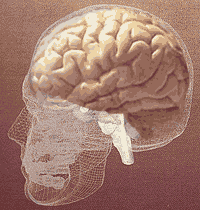
What is dopamine? It's hard to understand nicotine addiction, or any form of drug addiction for that matter, without a basic understanding of the brain's primary motivation neurotransmitter, dopamine. The brain's dopamine pathways serve as a built-in teacher. It uses a desire, yearning or wanting sensation to get our attention when it's time to pound home a survival lesson necessary to keep us humans alive and thriving.
Have you ever wondered why it's so hard to go without eating, to starve yourself to death, or for that matter, to die of thirst? Why do we seek acceptance by our peers, want companionship, and desire a mate or sexual relations? Why do we feel anxiety when bored and an "aaah" sense of relief when we complete a task?
Remember the very first time your parents praised you for keeping your coloring between the lines? Remember the "aaah" relief sensation you felt? That was dopamine, the satisfaction of your wanting to succeed. The deep inner primitive brain (the limbic mind) is hard-wired, via dopamine pathways, to keep us drinking liquids, fed, and together (there's "safety in numbers"), while achieving and reproducing.
When we feel hungry our dopamine pathways are being stimulated, teasing us with anticipation "wanting" for food. If kept waiting, the anticipation may build into urges or even full-blown craves. Each bite we eat further stimulates dopamine flow until stomach peptides, at last, tell the brain we're full and wanting becomes satisfied.
But our brain doesn't stop with simply creating and satisfying wanting associated with species survival events such as eating, drinking liquids, bonding, nurturing, accomplishment and sex. It makes sure that we don't forget them, that in the future we pay close attention to these activities.
The brain records how wanting was satisfied in the most durable, high-definition memory the mind may be capable of generating. It does so by hard-wiring dopamine pathway neuro-transmissions into our conscious memory banks (the prefrontal cortex - the lobe above our eyes), thus linking the event to wanting's satisfaction.
Referred to as "adaptive memory," dopamine flags motivationally significant events for long-term memory, thereby ensuring that they're protected and available to influence future behavior.
Drug Addiction's Common Thread
Now ponder this. What would happen if, by chance, an external chemical existed that once introduced into the bloodstream was small enough to pass through the blood/brain barrier (a protective filter), and once inside the brain was somehow able to stimulate or activate our mind's dopamine pathway circuitry? Could that chemical hijack the mind's priorities teacher?
If so, how long would it take before continuing use of the chemical resulted in the person becoming totally yet falsely convinced that using more of the chemical was as important as eating food?
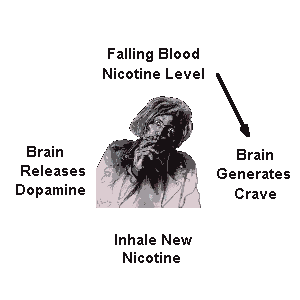 Hunger for food, hunger for nicotine. Food craves, nicotine craves. "Aaah" wanting satisfaction while taking bites, "aaah" satisfaction while replenishing nicotine reserves.
Hunger for food, hunger for nicotine. Food craves, nicotine craves. "Aaah" wanting satisfaction while taking bites, "aaah" satisfaction while replenishing nicotine reserves.
Addicted to inhaling an insecticide, welcome to the addict's world of nicotine normal, a world built on lies. For if we don't eat food we die, while if we stop using nicotine we thrive!
Clearly, I've vastly oversimplified an extremely complicated topic. While dopamine pathway stimulation is the common thread between chemical addictions (including cocaine, heroin, meth, nicotine and alcoholism), my simplified explanation does not explain why users initially continue using the drug prior to a growing pile of high-definition dopamine pathway use memories begin begging them to use more. Nor does it explain why most regular nicotine users get hooked but not all, or why quitting is often accompanied by withdrawal symptoms.
Although enhanced dopamine flow is associated with all chemical addictions, each chemical differs in how it triggers or enhances stimulation, how long stimulation lasts, and each chemical's ability to produce a different "high" sensation by interacting with other neurochemicals and pathways.
Aside from enhancing dopamine flow, nicotine is a central nervous system stimulant. As such, it activates the body's fight or flight response. This results in an alert-stimulated high. This allows us nicotine addicts to feel different or even superior to illegal drug addicts who fill the world's prisons. This, even though last year addiction to smoked nicotine killed 6.8 times as many Americans as all illegal drugs combined (480,000 versus 70,630).
While nicotine stimulates the nervous system, alcohol has the opposite effect in actually depressing it and slowing normal brain function. Heroin's dopamine stimulation is accompanied by an endorphin high, resulting in a short yet intense numbing or analgesic effect. Cocaine's high is a sense of stimulated euphoria associated with delaying normal clean-up (re-uptake) of multiple neurotransmitters (dopamine, serotonin and nor-adrenaline). And methamphetamine is the maximum speed stimulant.
 Again, the common thread between each of these addictions is that the brain's dopamine pathways were taken hostage and left the addict totally yet falsely convinced that continuing drug use was important to their survival, that their drug gave them their edge, helped them cope, and that life without it would be horrible.
Again, the common thread between each of these addictions is that the brain's dopamine pathways were taken hostage and left the addict totally yet falsely convinced that continuing drug use was important to their survival, that their drug gave them their edge, helped them cope, and that life without it would be horrible.
What we nicotine addicts could not see was that our beliefs and thinking about that next fix were unworthy of belief. The way to end wanting wasn't to use again. In fact, that is the only way to guarantee that wanting never ends.
Once hooked, it was too late. High-definition pay-attention memories generated by our dopamine pathways were now so vivid and durable that they quickly buried all remaining memories of life without nicotine. Gone were our pre-addiction memories of the calm, quiet, and beauty of the mind we previously called home.
It's why getting off of drugs is so difficult. It's why half of the smokers we see each day will eventually smoke themselves to death. While their friends and loved ones scream the insanity of their continued self-destruction, their brain dopamine pathways scream even louder that continuing drug use is as important as life itself.
Who should they believe, their limbic mind begging for that next fix or the outside world begging them to stop?
Nicotine Dependency is a Mental Illness
 I'm sorry but there's simply no nice way to say this. Nicotine dependency, like alcoholism, is a real mental illness. While able to fully and comfortably arrest our chemical addiction, there is no cure. It's permanent.
I'm sorry but there's simply no nice way to say this. Nicotine dependency, like alcoholism, is a real mental illness. While able to fully and comfortably arrest our chemical addiction, there is no cure. It's permanent.
Like alcoholism, there's just one rule. Once we're free, just one, using just once and we have to go back. You see, it isn't a matter of how much willpower we have, but how the brain's priorities teacher teaches, how nerve and memory cell highways that recorded years of nicotine feedings have left each of us grooved and wired for relapse.
So why are some people social smokers able to take it or leave it, while the rest of us got hooked? Referred to as "chippers," they probably account for less than 10% of all smokers. Jealous? If so and still using, don't worry, it's normal. That's what enslaved brains tend to dream about, to want to become like them, to control what for us is uncontrollable.
Being immune to addiction is believed to at least in part be related to genetics. But with up to 90% of daily users hooked solid under DSM standards, spending millions studying nicotine dependency genetics seems almost laughable. Before feeling too sorry for yourself, imagine what it's like to be an alcoholic and be forced to watch roughly 90% of drinkers do something that you cannot, turn and walk away. We only have to watch the 10% who are chippers.
Then again, we were each once chippers too, at least for our first couple of cigarettes, vaping sessions, or oral tobacco uses. There was no urge, desire, craving, hunger or wanting for those first couple of smokes. Nicotine stimulated our nervous system without our brain begging us to come back and do it again. There was no dopamine "aaah" relief sensation, as nothing was missing and nothing in need of replenishment. But that was about to change.
86.8% of students who smoke nicotine at least once daily are chemically dependent under DSM IV mental health standards

Diminished autonomy and control over smoking are seen in 25% of students after smoking nicotine only once and in 35% after smoking it 3 to 4 times.
Most of us became hooked while children or teens. What none of us knew before that first hit of nicotine was how extremely addictive smoking was. Roughly 26% of us started losing control over continued smoking after just 3 to 4 cigarettes, rising to 44% after smoking 5 to 9.
What we didn't then know was that within 8 to 10 seconds of that very first puff, up to 50% of our brain's dopamine pathway acetylcholine receptors would become occupied by nicotine, or that before finishing that first cigarette nicotine would saturate almost all of them.
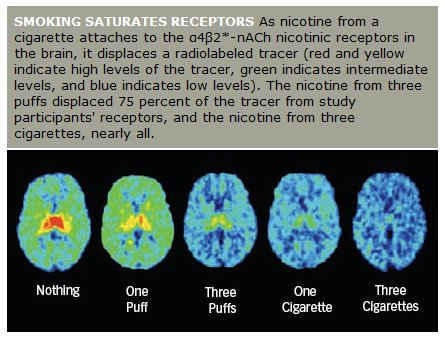
No one told us that once saturated, continued smoking would cause our receptors to become de-sensitized, which would somehow cause our brain to grow or activate millions of extra receptors, a process known as up-regulation.
Roughly every two hours the amount of nicotine remaining in our bloodstream declined by half (known as nicotine's elimination half-life). At some point in the process, continued stimulation, de-sensitization and up-regulation left our brain wanting and begging for more. An addiction was born as our brain was now wired to function with gradually increasing amounts of nicotine.
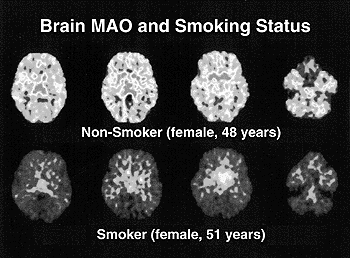
Not only does nicotine stimulate the release of dopamine within ten seconds of a puff, at least one other smoked chemical suppresses MAO, a dopamine clean-up enzyme. Suppressing MAO allows wanting's satisfaction to linger far longer than a natural release, such as the short-lived sensations felt when eating food or quenching thirst.
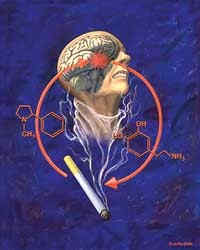 One cigarette per day, then two, then three, as if trying to avoid experiencing cravings by smoking early and often, the longer we smoked nicotine, the more receptors that became saturated and desensitized, the more grown, and the more nicotine needed to satisfy resulting "wanting" for replenishment.
One cigarette per day, then two, then three, as if trying to avoid experiencing cravings by smoking early and often, the longer we smoked nicotine, the more receptors that became saturated and desensitized, the more grown, and the more nicotine needed to satisfy resulting "wanting" for replenishment.
As America's leading drug addiction expert puts it, the NIDA's Dr. Nora Volkow, drug addiction brain changes translate into an inability to control drug intake. These drug-induced brain modifications then signal the brain with a message that's equivalent to "when you are starving," the signal to "seek food and eat it," that the drug is "necessary to survival," that dopamine pathways ensure "long-lasting memory of salient events."
Our priorities hijacked, our mental disorder having left us convinced that that next nicotine fix is as important as food, where do we turn once we awaken and realize that we've been fooled?
The Good News
The good news is that it's all a lie, that drug addiction is about living a lie. It's dirty, destructive and time-consuming work chopping up life into the distance between mandatory nicotine feedings..  The good news is that knowledge is power, that we can each grow far smarter and wiser than our addiction is strong. Full recovery is entirely doable for all. In fact, today there are more comfortable ex-smokers in the U.S. than smokers.
The good news is that knowledge is power, that we can each grow far smarter and wiser than our addiction is strong. Full recovery is entirely doable for all. In fact, today there are more comfortable ex-smokers in the U.S. than smokers.
While the first few days may feel like an emotional train wreck, beyond them, with each passing day the challenges grow fewer, generally less intense and shorter in duration. Recovery leads to a calm and quiet mind where addiction chatter and wanting gradually fade into rarity, where the ex-user begins going days, weeks or even months without once feeling a wanting for nicotine.
Recovery is good, not bad. Our healing needs to be embraced not feared. The good news is that everything done while under nicotine's influence can be done as well or better without it.
"Our brain has tremendous capacity for recovery," says Dr. Volkow. While no cure, there is only one rule that if followed provides a 100% guarantee of success in arresting it -- no nicotine today.
Successful Recovery
Each year, more successful ex-users quit cold turkey than by all other methods combined. Their common thread? No nicotine, just one hour, challenge and day at a time. The common element among all who relapsed? A puff of nicotine.
On a conscious level, roughly 70% of daily smokers and 62.4% of e-cigarette users want to stop. But few understand how and even fewer appreciate that they're dealing with a permanent priorities disorder and illness of the mind. Instead, they invent justifications and rationalizations to explain why they must smoke that next cigarette.
Subconsciously, you've established nicotine use cues. Those cues trigger urges or craves upon encountering a specific time, place, person, situation or emotion during which you've trained your mind to expect a new supply of nicotine. But the catalyst and foundation for both conscious rationalizations and subconscious conditioning is your underlying chemical dependency.
Trapped between nicotine's two-hour elimination half-life and a gradually escalating need to smoke harder or more, the dependent smoker faces five primary recovery hurdles: (1) appreciation for where they now find themselves, (2) reclaiming their hijacked dopamine pathways, (3) breaking and extinguishing smoking cues, (4) abandoning smoking rationalizations, and (5) relapse prevention.
The Law of Addiction
Most quitting literature suggests that it normally takes multiple failed quitting attempts before the user self-discovers the key to success. What they fail to tell you is the lesson that's eventually learned, or that it can be learned and mastered during the very first try.
Successful recovery isn't about strength or weakness. It's about a mental disorder where by chance our dopamine pathway receptors have eight times greater attraction to a nicotine molecule than to the receptor's own neurotransmitter. We call it the "Law of Addiction" and it states:
"Administration of a drug to an addict will cause re-establishment of chemical dependence upon the addictive substance."
Roughly half of quitters who relapse report thinking that they thought they could get away with using just once. The benefit of fully accepting that we have a true chemical dependency and permanent priorities disorder can't be overstated. It greatly simplifies recovery's rules while helping protect against relapse.
Key to arresting our illness is obedience to one simple concept, that "one puff would be too many and thousands not enough." There was always only one rule, no nicotine just one hour, challenge (if any,) and day at a time.
Navigating Withdrawal and Reclaiming Hijacked Dopamine Pathways
Like clockwork, constantly falling nicotine reserves soon had hostage dopamine pathways generating wanting for more. Sensing that "want" thousands of times per year, how could we not expect to equate quitting 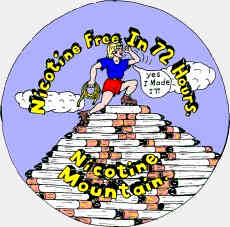 to starving ourselves to death?
to starving ourselves to death?
Again, the essence of drug addiction is about dependency quickly burying all memories of our pre-dependency self. Thus, the first step in coming home and again meeting the real us is emptying the body of nicotine.
It's amazingly fast too. Cut by half every two hours, our mind and body become 100% nicotine-free within 72 hours of ending all use. Extraction complete and peak withdrawal behind you, true healing can begin. While receptor sensitivities are quickly restored, down-regulation of the number of receptors to levels seen in never-users may take up to 21 days.
But within two to three weeks your now arrested dependency is no longer doing the talking. Quitting fears and dread are gradually thawing and melting into "like" or even "love." You're beginning to sense the truth about where you've been.
It's critical during early withdrawal to not skip meals, especially breakfast. Attempting to do so will likely cause blood sugar levels to plummet, making recovery far more challenging than need be. Why?
A stimulant, nicotine activates the body's fight or flight response,
 feeding the addict instant energy by pumping stored fats and sugars into the bloodstream. It allowed us to skip breakfast and/or lunch without experiencing low blood sugar symptoms such as feeling nervous or jittery, trembling, irritability, anxiousness, anger, confusion, difficulty thinking or an inability to concentrate. Minimize or avoid those symptoms. Eat little, healthy and often.
feeding the addict instant energy by pumping stored fats and sugars into the bloodstream. It allowed us to skip breakfast and/or lunch without experiencing low blood sugar symptoms such as feeling nervous or jittery, trembling, irritability, anxiousness, anger, confusion, difficulty thinking or an inability to concentrate. Minimize or avoid those symptoms. Eat little, healthy and often.
If your diet and health permit, drink some form of natural fruit juice for the first three days. Cranberry juice is excellent. It will aid in stabilizing blood sugar while accelerating the removal of the alkaloid nicotine from your bloodstream.
Also, heavy caffeine users need to know that (as strange as this sounds), nicotine doubles the rate by which the liver eliminates caffeine from the bloodstream. One cup of coffee, tea or one cola may now feel like two. While most caffeine users can handle a doubling of intake, consider a modest reduction of up to one-half if feeling anxious, irritable or unable to sleep following caffeine use.
One caution. While we need not give up any activity except nicotine use, use extreme caution with early alcohol use as it is associated with roughly 50% of all relapses.
Extinguishing Use Conditioning
 Embrace recovery don't fear it. Why fear a temporary journey of re-adjustment that transports us to a point in time where we're going days, weeks and eventually months without wanting to use nicotine?
Embrace recovery don't fear it. Why fear a temporary journey of re-adjustment that transports us to a point in time where we're going days, weeks and eventually months without wanting to use nicotine?
Each cue-driven crave episode presents an opportunity to extinguish additional conditioning and reclaim another aspect of life. We may have trained our minds to expect nicotine during stressful events, when walking in the backyard, while driving a car, talking on the phone or upon encountering another user. Attempting these activities after stopping may generate a short yet possibly powerful crave episode.
Success in moving beyond each episode awards the new ex-user return of another slice of a nicotine-free life: heightened control during crisis, return of the yard, car, phone or friends. But be sure and look at a clock during craves as normal cessation time distortion can combine with fear or even panic to make a less than 3-minute episode feel far longer.
Research suggests that the average quitter experiences a maximum of 6 crave episodes per day on the third day of recovery, declining to about 1.4 per day by day ten. If each craving is less than 3 minutes and the average quitter experiences a maximum of 6 on their most challenging day, can you handle 18 minutes of challenge?
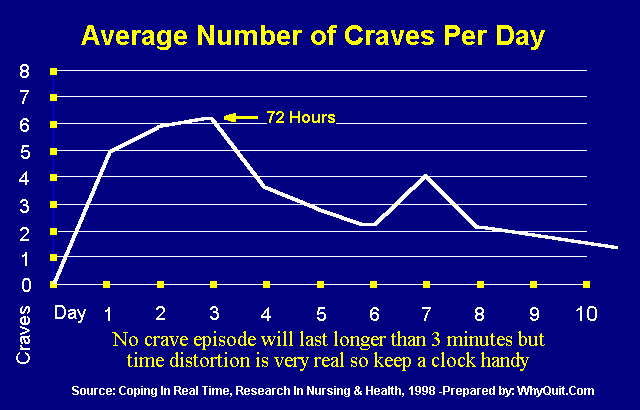
But what if you're not average or normal? What if, instead, you've created twice as many nicotine use cues as the "average" addict? Can you handle 36 minutes of significant challenge if it means arresting your dependency, improving your mental and physical health, and the prospect of more coins, time and greater self-esteem? Absolutely!
Abandonment of Use Rationalizations
Full acceptance that nicotine addiction is a mental disorder and that we're just as addicted as the alcoholic, heroin or meth addict destroys the need for nicotine use rationalizations. Try this. List your top ten reasons for using. Now go back and cross off all reasons except the truth: that hijacked pay-attention pathways kept us wanting for more.
If a smoker, you didn't continue destroying your body's ability to receive and transport life-giving oxygen because you wanted to. You did so because a rising tide of withdrawal anxieties would begin to hurt when you didn't.
 Contrary to convenience store tobacco marketing, and as the vaping e-cig addict will attest, we did not smoke for the flavor or taste of fine tobacco. In fact, there are zero taste buds inside human lungs. Contrary to hundreds of store "pleasure" signs, drug addiction isn't about seeking pleasure but about satisfying a brain "wanting" disorder.
Contrary to convenience store tobacco marketing, and as the vaping e-cig addict will attest, we did not smoke for the flavor or taste of fine tobacco. In fact, there are zero taste buds inside human lungs. Contrary to hundreds of store "pleasure" signs, drug addiction isn't about seeking pleasure but about satisfying a brain "wanting" disorder.
Our mind's priorities disorder had most of us convinced that we liked or even loved smoking. But what basis did we have for making honest comparisons? Try hard to recall the calm inside your mind before getting hooked; going days, weeks and months without once having an urge or craving to smoke.
You can't do it, can you? So what basis exists to make honest comparisons about liking the addicted you more than the free you? It isn't that we liked smoking but that we didn't like what happened when we didn't, the onset of withdrawal.
Most of us convinced ourselves that we smoked to relieve stress when in reality our addiction intensified it. While nicotine is an alkaloid, stress, alcohol and vitamin C are each acid-generating events that accelerate renal (kidney) elimination of nicotine from the bloodstream.
Stressful situations cause the release of stress hormones (cortisol and adrenaline) that quickly turn urine more acidic. A urine acid increase from a pH of 5.6 to 4.5 would increase the rate of nicotine elimination by 208%. The onset of early withdrawal due to accelerated elimination would force immediate nicotine replenishment. Within ten seconds of replenishment, the crisis was over, at least the dependency-induced portion.
Just as important, the silencing of stress-related wanting was recorded in long-term high-definition memory, guaranteeing a deep-rooted belief that nicotine is a stress-buster when all it had done was service our addiction.
Think about it. Once we finished tanking up with a new supply of nicotine and had satisfied our dependency, the car's tire was still flat, or the bad news was still bad. One of the greatest recovery gifts of all is greater calm and control during crisis, as we're no longer adding nicotine withdrawal atop every stressful event.
One of the most destructive rationalizations is pretending that all we suffer from is a nasty little habit such as using a cuss word now and then, that we can smoke just once, now and then, after quitting and get away with it.
Why tease yourself? Willpower cannot stop smoked, vaped, chewed or sucked nicotine from arriving in the brain. Ask yourself, how many marathon runners have the endurance to run two marathons in a row? While we may walk away from one hit and relapse thinking that we've gotten away with it, as sure as the sun rises in the sky our mental illness will soon be begging for more. We can no more take a hit than an alcoholic can take a sip.
"But now just isn't the right time," you say. Frankly, there will never be a perfect time or a better time than now. Planning and putting it off until some future date actually breeds needless anticipation anxieties that diminish the odds of success. As backward as this sounds, two studies, one in the UK and the other in the US, found that unplanned attempts are twice as successful as planned ones. The next few minutes are totally within our ability to control and each is entirely doable.
One concern Dr. Volkow hears is that by teaching users that they have a chemical addiction that's a mental illness, some will use it as an excuse for avoiding responsibility in arresting it. But as she notes, does a person who's told that they have cancer or heart disease pretend helplessness, or do they instead fight to save and extend their life?
As with me, nicotine dependency recovery can be our greatest personal awakening ever. Imagine destroying needless quitting fears by understanding them, and thus being able to better notice and savor the beauty about to unfold before you.
No longer afraid, imagine noticing your breathing improving and the richness sensed by rapidly healing taste buds. Imagine discovering that white flour and raindrops have a smell, while moving into a clean ash-free and e-liquid-free world where the oil on your skin isn't tar's or nicotine's but yours. Imagine the return of self-respect, of being home and residing here on Easy Street with hundreds of millions of comfortable ex-users, of knowing it's a keeper, and never having to quit again.
Relapse Prevention
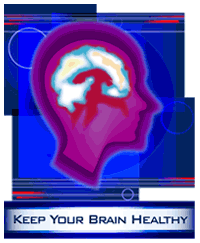 "One day at a time" is a focus accomplishment skill. Why worry about how much of the mountain is left to climb or how far we could fall when all that matters is our grip upon here and now, the next few minutes? Combining the "Law of Addiction" with a "one day at a time" recovery philosophy is all that's needed to remain free and keep our mind's priorities disorder arrested for life.
"One day at a time" is a focus accomplishment skill. Why worry about how much of the mountain is left to climb or how far we could fall when all that matters is our grip upon here and now, the next few minutes? Combining the "Law of Addiction" with a "one day at a time" recovery philosophy is all that's needed to remain free and keep our mind's priorities disorder arrested for life.
The greatest unsolved mystery is why after having successfully quit for 5, 10 or even 30 years, it only takes a single lapse in judgment - using on just one occasion - to trigger a full and complete relapse. To quote from a study released on May 16, 2011, "Nearly all smokers who lapse experience a full-blown relapse."
What makes our mental illness permanent? Did years of using somehow burn or etch permanent dependency tracks into our brains? Does new nicotine somehow turn on our addiction switch? Once the brain restores natural receptor counts (down-regulates), is some record kept of how many receptors there once were? Or, does one powerful hit of nicotine simply awaken thousands of old memories of an addict having satisfied "wanting" for more?
Frankly, science doesn't yet know. What it does know is that it's impossible to fail so long as all nicotine remains on the outside, that there was always only one rule, no nicotine, just one hour, challenge and day at a time. The next few minutes are yours to command and each is entirely doable. Baby steps to glory. Yes, you can!
In your mind, see and treat that first hit of nicotine as if the survival rate is zero. None of us are stronger than nicotine. But then we don't need to be as it is simply a chemical with an I.Q. of zero. It cannot plot, plan or conspire, and contrary to the teachings of the UK's leading cessation educator (whose lessons are otherwise high quality), no demon or monster is dwelling within us. Our most effective weapon against nicotine is and always has been our vastly superior intelligence, but only if put to work.
Vaping E-cigarettes or Using Nicotine Replacement Products
The e-cig industry wants you to remain a slave to buying and vaping its nicotine, every waking hour of every day, until the day you die. Although fully aware that you stand less than 72 hours from moving beyond peak withdrawal, it hides this truth in order to play, prey and feed upon your wanting for that next fix.
Do not expect it to ever tell you the truth about how amazingly doable recovery is or how serene it feels once your addiction's never-ending chatter goes silent.
Watch as it tries to convince you that slavery is freedom and that nicotine is as safe as caffeine. But when is the last time we saw anyone inhale tea or coffee grounds? And what are the long-term consequences of inhaling a known cancer promoter, especially if your lungs and body are already damaged by years of smoking?
The nicotine replacement therapy (NRT) industry wants smokers to believe that a natural poison is medicine, that its use is therapy, and that it's somehow different from the tobacco plant's nicotine molecule. Imagine trying to convince us to extend the up to 72 hours needed to empty our body of nicotine by toying for weeks or months with gradual nicotine weaning schemes, that the solution to nicotine dependency is more nicotine.
Truth is, the pharmaceutical industry buys its nicotiana from the exact same growers as the tobacco industry. They want us to believe that double-blind placebo-controlled studies proved that NRT doubles a cold turkey quitter's odds of quitting and that only superheroes can quit without it. Truth is, their studies were not blind as claimed and did not involve quitters who wanted to quit cold turkey. Truth is, out here in the real world, as shown by a July 2013 Gallup Poll, more ex-users quit nicotine cold turkey than all other quitting methods combined.
Here are a few facts that those selling creative nicotine delivery devices would rather you not know:
- Although obviously safer than smoking, transfer to e-cigarettes or smokeless tobacco is both dangerous and not about quitting but dependency transfer. It's easy to tell the nicotine salesman from the truth-teller. Those with your best interests in mind won't hesitate to remind you that the smart move is not harm reduction, but nicotine cessation and harm elimination.
- And you can quit. As of 2018, 61.7% of U.S. smokers had already quit, the vast majority without use of any approved quitting product.
- Truth is, cessation science has generally been beholden to the pharmaceutical industry and with few exceptions appears intellectually corrupt. Placebo-controlled NRT, Zyban, Chantix and NicVax clinical studies have not been blind as claimed and thus have no foundation in science. Think about it. Researchers cannot hide the presence or absence of withdrawal from users with significant quitting histories; addicts who became experts at knowing exactly how withdrawal feels. A 2004 review found that NRT studies suffered from widespread blinding failures (May 2004). A 2009 study by the inventor of the nicotine patch found that 4 times as many study participants randomly assigned to wear the placebo nicotine patch correctly determined their group assignment as guessed wrong. Placebo-controlled quitting product clinical trials did not measure NRT "efficacy" but expectations and frustrations.
- Those using the over-the-counter (OTC) nicotine patch or gum as a stand-alone quitting product have about a 7% chance of quitting smoking for six months (March 2003).
- Up to 6.7% of OTC nicotine gum quitters are still chronic users of nicotine gum at six months (November 2003). The math makes you wonder if any gum user actually breaks free from nicotine while chewing it (May 2004).
- 36.6% of all nicotine gum users were found to be chronic long-term users (May 2004).
- Studies suggest that you truly would have to be a superhero to quit while using the nicotine patch if you'd already attempted using it once and relapsed. Two patch user "recycling" studies show that nearly 100% of second-time nicotine patch users relapse to smoking nicotine within six months (April 1993 and August 1995, see Table 3).
- The vast majority of long-term ex-smokers quit entirely on their own without resorting to any product, procedure or program of any kind including hypnosis, Zyban, Chantix, Champix, acupuncture, magic herbs, laser therapy, or the nicotine patch, gum, lozenge, spray, or inhaler.
- Cold turkey quitters have prevailed over NRT quitters in all long-term real-world population-level observational studies over the past decade. For example, a 2006 Australian survey of 8,333 family practice patients found cold turkey twice as effective as NRT. It also found that cold turkey accounted for 88 percent of all successful quitters (1,942 of 2207).
- Studies comparing those who have successfully arrested their dependency to those still slaves to a new form of delivery shout freedom's real winners.
- Education, understanding, new skills and some form of ongoing quality support can easily triple your odds of success.
- Better yet, those who refuse to allow any nicotine back into their bloodstream have 100% odds of remaining nicotine-free today! (Today, Tomorrow & Always!).
Education (Smart Turkey) Is a Quitting Method
Is it possible to become so educated and motivated that the deep inner mind no longer sees ending nicotine use as a threat, so much so that the body's emotional fight or flight anxiety alarms hardly ever get sounded? Roughly half of quitters report that recovery was far easier than expected. Is it possible to so embrace coming home that your fears evaporate and it feels like a cakewalk? Absolutely!
Did you know that unplanned attempts, which avoid anticipation-induced fears, are up to 2.6 times as effective as planned attempts?
Why wait? Scroll through the titles of WhyQuit's nearly 500 free video lessons or grab one of our free quitting ebooks and jump in the pool. The next few minutes are all that matter and each is entirely doable. It may not always be easy but it is simple. In fact, there was always only one rule ... no nicotine today!
Nicotine Cessation Educator
Updated 12/31/22
Share Nicotine Addiction 101
Tobacco company deception about
chemical addiction to nicotine
2003 Internet Statement
"Philip Morris USA agrees with the overwhelming medical and
scientific consensus that cigarette smoking is addictive."
1994 Congressional Testimony
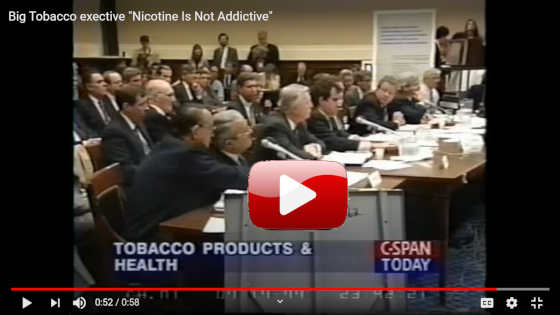
Watch the April 14, 1994 testimony, under oath, of seven tobacco company chief executive officers (CEOs) before the United States House of Representatives Committee on Energy & Commerce,Subcommittee on Health and the Environment.
"I believe that nicotine is not addictive, yes". Philip Morris CEO (Chief Executive Officer) William I. Campbell
Congressman Wyden: "Mr. Johnston ..."
"Uh, Congressman, cigarettes and nicotine clearly do not meet the classic definition of addiction. There is no intoxication--" R.J. Reynolds Tobacco Company CEO James Johnston
Congressman Wyden: We'll take that as a no. And again, time is short, if you can just, I think each of you believe nicotine is not addictive, I'd just like to have this for the record.
"I don't believe that nicotine or our products are addictive." U.S. Tobacco Company CEO Joseph Taddeo
"I believe that nicotine is not addictive." Lorillard Tobacco Company CEO Andrew Tisch
"I believe that nicotine is not addictive." Ligget Group CEO Edward Horrigan
"I believe that nicotine is not addictive." Brown & Williamson Tobacco Company CEO Thomas Sandefur
"And I too believe that nicotine is not addictive." American Tobacco Company CEO Donald Johnston
1972 Secret Memorandum
"[N]icotine is the sine qua non of smoking, and if we meekly accept the allegations of our critics and move toward reduction or elimination of nicotine from our products, then we shall eventually liquidate our business."
European Union Addiction Warning Label
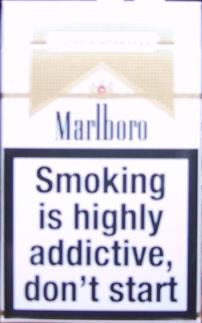
Addiction warnings have appeared on cigarette packs in Canada since 2000, the European Union since 2003 (changed 2005), Australia since 2006 and New Zealand since 2008. But still no addiction warning for United States youth. Why?
How Does Nicotine Addict Us?
John R. Polito
Nicotine addiction a mental illness
WhyQuit.com
How long does it take to get hooked?
Dr. George B. Johnson
How Addictive is Nicotine?
New York Times, 1994
Relative addictiveness of various substances
Health, 1990
Nicotine as addictive as heroin
Reuters News
70.7% of youth smokers dependent under DSM-IV standards
2003 Spanish Youth Dependency Study
90% of adult smokers dependent under DSM-III standards
American Journal of Psychiatry February 1987
How is Nicotine Addiction Defined?
Tobacco Control, 2002, Joseph R. DiFranza, MD
ICD-10 World Health Organization's Standard
World Health Organization
Are You Addicted to Nicotine?
by Joel Spitzer
Rodrigo de Jerez gets hooked and lands in prison
The story of the first nicotine dependent European
Nicodemon's lies?
by John R. Polito
"I'm just too weak to quit smoking"
by Joel Spitzer
Nicotine's Destructive Potential
by Dr. K.H. Ginzel, MD
Studies conflict on whether nicotine promotes cancer
Science Daily - January 2003
Long-term nicotine replacement therapy: cancer risk in context
Cancer Prevention Research - November 2011
Does nicotine accelerate cancer tumor growth rates and spreading?
WhyQuit review of 2009 study and Critical Reviews of Toxicology - November 2011
Growing concerns that nicotine may promote breast cancer
2010 National Cancer Institute Press Release
Nicotine is accused of causing hardening of arteries - atherosclerosis
Stanford University School of Medicine - July 2001
Nicotine is believed to worsen the outcome and increase incidence of strokes
2010 Texas Tech study finding
Long term nicotine gum users express hair and tooth loss concerns
2008 WhyQuit article on long-term nicotine gum users
Studies conflict on whether nicotine promotes lung cancer
University of Minnesota Cancer Center - November 2000
and Cancer Prevention Research - November 2011
Nicotine may cause brain damage & may be linked to chronic depression
by the Surgeon General - 2023 and
May 2015 prospectivce study of 34,000 participants.
How nicotine harms the fetus, infant and adolescent
by Dr. K.H. Ginzel, MD, and others - 2006
Nicotine is a teratogen that can devastate a human fetus
A host of recent medical studies
Nicotine Warning for Cold Turkey Quitters
If a cold turkey quitter, remain alert to the fact that most quitting web sites, including government sites, contain advertisements, quitting instructions or articles that were written by pharmaceutical industry financial influence for the purpose of getting you to purchase and use nicotine.
What they fail to warn you about is the fact that if you have remained 100% nicotine free for 72 hours, that your blood and body are now 100% nicotine-clean, that chemical withdrawal has peaked in intensity and is now beginning to gradually subside. Any nicotine use at this point will cause chemical relapse that will require you to repeat the nicotine detox portion of recovery again. This is the "Law of Addiction."
The industry's super slick marketing is designed to leave you believing that you have very little chance of succeeding unless you rush-out and purchase nicotine replacement therapy (NRT) weaning products such as the nicotine patch, nicotine gum or nicotine lozenge and immediately put nicotine back into your bloodstream. They do not want you to believe in "you." They do not want you to reach for education, understanding, new skills and support, "smart turkey" tools which make dreams come true at rates that make those achieved by their products sadly laughable.
Knowledge is a Quitting Method
